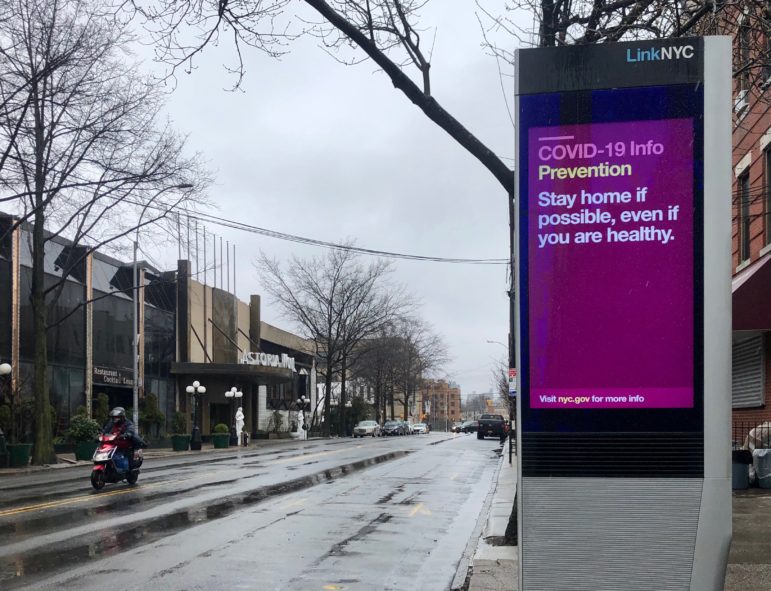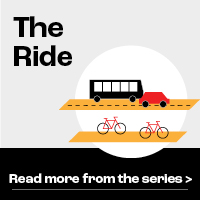
Jeanmarie Evelly
A food delivery worker rides down an otherwise empty Astoria Boulevard on Monday, March 23. Advocates have called for street-use changes in response to the ongoing health crisis .
UPDATED 3/25/20: Mayor Bill de Blasio announced the city will be testing a pilot program that will close “up to two streets” in each borough to create more social distancing space. Those streets should be “up and running” by Thursday, the mayor said, and will be enforced by the NYPD and other city agencies.
Over the weekend, Gov. Andrew Cuomo demanded the city come up with a plan to keep residents from congregating in public parks amid the COVID-19 outbreak, calling the outdoor crowds “wholly inappropriate” at a time when health experts urge people to practice social distancing.
“This is not life as usual,” Cuomo said during a press briefing Sunday, where he said he’d spoken with both Mayor Bill de Blasio and Council Speaker Corey Johnson about the problem.
“There are many options. You have much less traffic in New York City because non-essential workers aren’t going to work. Get creative. Open streets to reduce the density,” the governor added. “You want to go for a walk? God bless you. You want to go for a run? God bless you. But let’s open streets, let’s open space. That’s where people should be, in open spaces areas, not in dense locations.”
As coronavirus continues to spread through New York—the city was home to 13,119 positive cases and 125 fatalities as of Monday night, according to the mayor’s office—it’s shifting how we consider and allocate public space, and streets in particular. Cuomo’s call to open some roads to the public echoes those of transportation advocates and other lawmakers, including Johnson, as they look for ways to keep residents safe and sane in a crowded city.
“I was in Fort Tryon [Park] in upper Manhattan over the weekend, and it was really difficult to maintain at least a six-foot-buffer from other people,” says Joe Cutrufo, of the advocacy group Transportation Alternatives, which is calling for the city to convert streets into social-distancing spaces. “If people are going to be able to maintain their physical and mental well-being while they’re in a state of semi-lockdown, they need to be able to get out and stretch their legs, and get some fresh air without coming into close contact with other people.”
The group, along with cycling advocacy organization Bike New York, released a list Monday of specific streets that could be converted to spaces for pedestrians, cyclists and emergency vehicles only. The groups also offered “to enlist a corps of volunteers to help construct and maintain these car-free corridors.”
The recommendations include streets that see closures for other reasons throughout the year, such as those along the New York Marathon route, street fairs, Summer Streets, and those in the city’s Play Streets program. The groups also suggest doing so for streets in neighborhoods that lack adequate park space nearby, and for setting up zones around hospitals that would be closed to traffic except for healthcare workers and ambulances.
Streets that run through parks, such as Shore Boulevard in Astoria Park, Forest Park Drive or Mosholu Parkway in Van Cortlandt Park would also be good options for traffic closures, the groups say.
The mayor’s office and the Department of Transportation did not immediately return a request for comment about potentially closing streets during the pandemic. When asked about it at a press briefing on Friday, de Blasio said modeling something off of the city’s Play Streets program is “an interesting idea” and that the city would look into doing things like better utilizing school yards, but fell short of committing to street closures.
“That’s something that’s going to be a real – a challenge in a different way because we don’t have the same personnel at the schools we normally do, but I think there are ways we can deal with that,” he said. “That is not necessarily the same as closing residential streets.”
Advocates have called for other street changes in response to the ongoing health crisis, including the expansion of the city’s bike lane network as more people take to cycling in an effort to avoid public transit, and bike shops have been deemed “essential” businesses.
On Thursday, City Councilman Jimmy Van Bramer tweeted about the need to open more space for cyclists and pedestrians on the Ed Koch Queensboro Bridge, calling for the bridge’s outer roadway to be closed to cars, a long-time demand of transportation advocates. Others have been pushing the MTA to allow for cycling across its bridges, which include the Triborough and Henry Hudson.
The mayor previously announced that the DOT is adding temporary bike lanes on Brooklyn’s Smith Street, as well as a stretch of Second Avenue in Manhattan.
“We’ll be looking for other areas all over the city that need them,” de Blasio told reporters Friday.
“Filling gaps in the city’s protected bike lanes network is one of the most important jobs the DOT could be doing. There are still plenty of essential workers who need to get to work, who are concerned about taking buses and trains,” says Cutrufo. “This crisis is really shedding a spotlight on the pent up demand for safe cycling infrastructure.”










